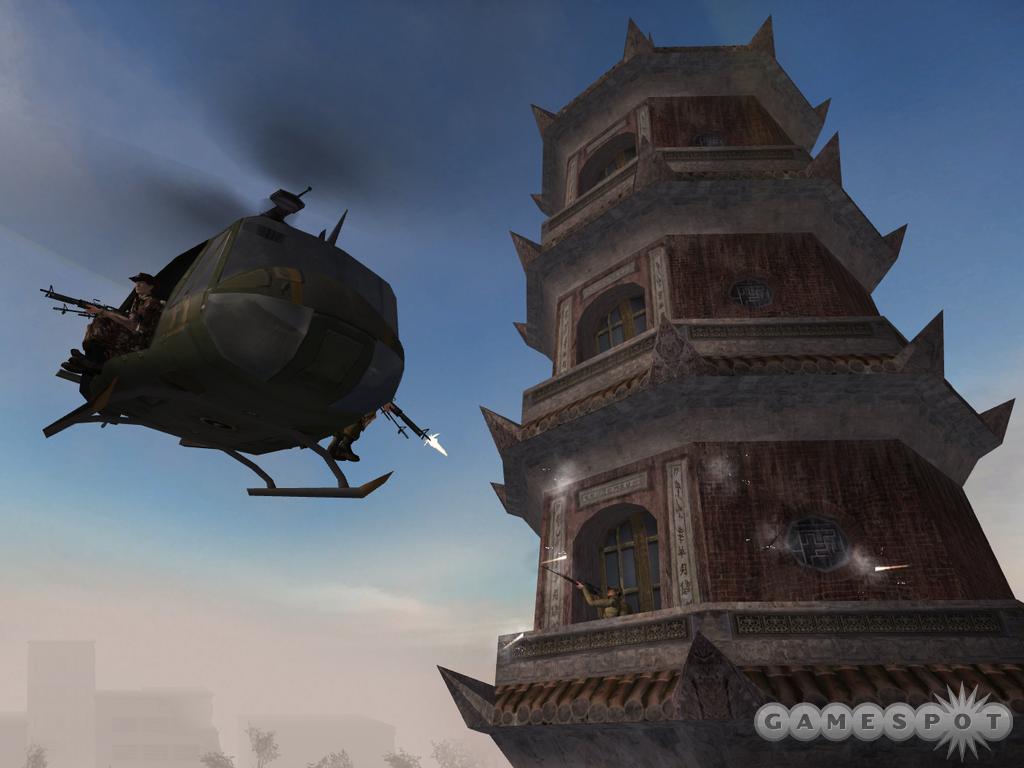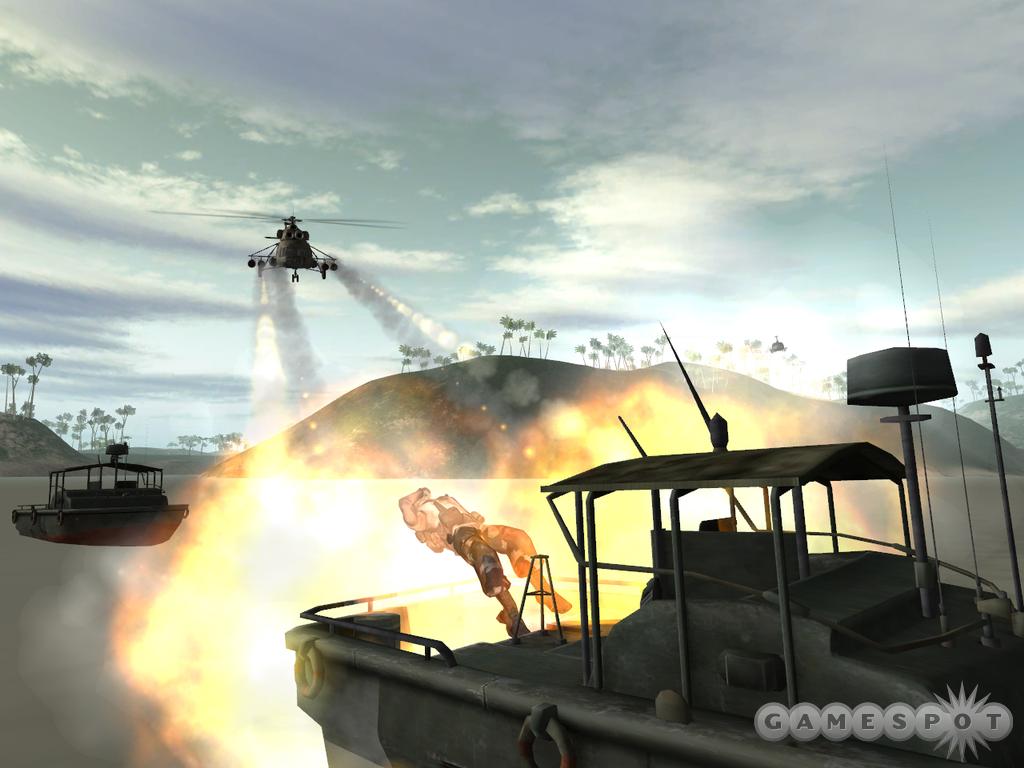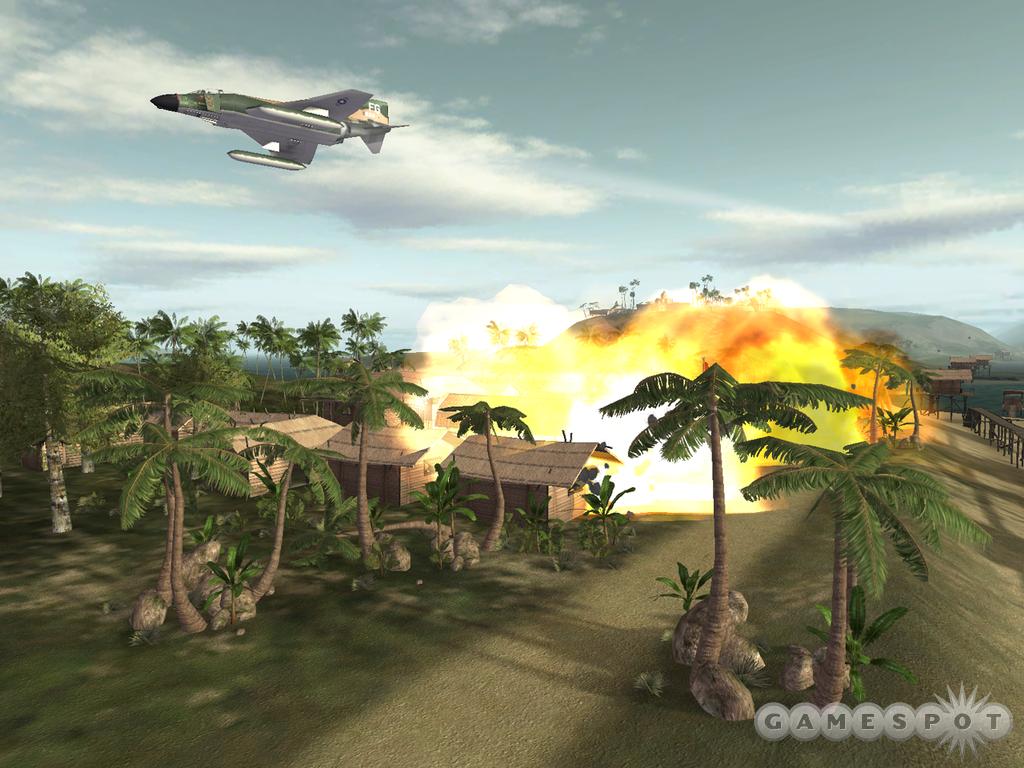Battlefield Vietnam Hands-On Preview
EA Games and Digital Illusions' next multiplayer shooter will have 25 percent more Creedence Clearwater Revival. We have the details.
First-person shooters started out by putting players in the role of a lone soldier who had to move fast and shoot faster to blast any nearby enemies. Then they got a whole lot better with the addition of multiplayer play--letting groups of players play with, and against, each other, first over a simple network connection, and now over the Internet. They've also become far more sophisticated and interesting, and one of the most intriguing of these new first-person shooters is last year's Battlefield 1942 from Digital Illusions and EA Games. The game let you play as a soldier in World War II who not only could carry different equipment kits and weapon loadouts, but could also jump into any nearby vehicle or turret and use it in spectacular combined-arms battles against online opponents. Now the development team is focusing on its next game, Battlefield Vietnam, a team-based shooter that takes place during war-era Vietnam. We recently had an opportunity to try out an early version of the game.

In our tour of duty, we had a chance to try out three different maps, each in the classic "conquest" mode, in which opposing teams compete to control various flags on the map. We played on Ho Chi Minh trail, a closely knit jungle map with tanks and jeeps restricted to narrow dirt roads; Operation Game Warden, a water-based map featuring speedboats; and Flaming Dart, a map ruled by Huey helicopters and F-4 Phantom jet fighters. Interestingly, most of the game's maps are based loosely on real-world engagements; the layout of Operation Game Warden is based on American skirmishes in and around the Mekong Delta, for instance. However, the game clearly emphasizes the fast-paced, pick-up-and-play style of Battlefield 1942 over historical accuracy or demanding physics. It also seems to place much more emphasis on infantry operations, as you might expect from a game that takes place in the jungles of Vietnam.
Like Battlefield 1942, Vietnam lets you choose from various soldier kits with different weapon and equipment sets before you jump into the fray, though the new game will also let you choose a customized face and body appearance (the current version featured only two heads and two bodies, though the final game will obviously offer more choices). Currently, the US side has four kits that resemble the main kits from 1942--assault, sniper, anti-vehicle artillery, and mechanic--and, interestingly, each one can currently choose one of two different primary weapons (in Flaming Dart, US assault characters can choose between an assault rifle and a shotgun, for instance), in addition to standard-issue pistols, knives, and either grenades or static charges. The weapon models seem larger and considerably more detailed than those of the previous game, and they come with lengthy idle and reload animations that show off your soldier's normal-mapped hands.
Infantry weapons are also considerably louder and seem more effective, at least in the Ho Chi Minh trail map, since the thick foliage at once provides better cover for foot soldiers while restricting vehicles to narrow roads. Vietnam actually features two layers of foliage--static undergrowth (high grass and bushes) and physically modeled "overgrowth," which includes tall trees that have mass and can be knocked over by tanks and other vehicles. Most weapons, especially the US troops' M16, seem to have more kick to them, which proved especially helpful, since that map, and several sections of the other maps, featured lots of uneven terrain, including good pockets of cover to help sidelong approaches into enemy territory. Assault soldiers were able to use these pockets to get up close and personal to enemies guarding flags, though snipers were just as well served by this extra cover, especially while prone in the high grass.
Operation Game Warden takes place in the Mekong Delta, so as you might expect, the level layout consists of flag control points on various islands separated by the river itself. Like Ho Chi Minh trail, this map seemed to drive players to congregate in certain areas, including spawn points for speedboats and narrow gangplanks perched high above the river. These stripped-down bridges provide absolutely nothing in the way of cover, making excellent targets of soldiers who happen to try crossing while an enemy chopper is nearby, though they do provide an excellent vantage point into the brush on the opposing shore. But these two methods of transportation, however dangerous, seem like the fastest way to get across the river--and since the river is too deep to wade through and requires you to lower your weapon while swimming, you're usually a sitting duck to try crossing in this manner.
Flaming Dart is a mostly land-based map that features plenty of aircraft, including the powerful Huey and Chinook combat helicopters and the devastating F-4 Phantom fighter jet. As you might expect, the F-4 is much faster than the P-51 and the Bf-109e fighter planes from the original Battlefield 1942, though experienced fliers will likely be able to apply their existing skills to the new plane. Choppers seem like a whole new experience, since their forward movement must be controlled by the throttle (just like real helicopters), so that rather than propel yourself forward with rear engines, you must angle the nose of your helicopter downward to move forward, dragging the rest of the craft along with it. While this seems to make changing directions in midflight difficult to impossible, especially when low to the ground and near trees and buildings that can be crashed into, the control scheme also allows for slower-moving strafing runs along the ground that are perfect for flushing out snipers hidden in the grass.
And as if tearing into fleeing ground troops while one of your onboard buddies uses the side-mounted machine gun to make a sideways sweep of the ground weren't exciting enough, all vehicles on the US side are equipped with a radio that can be accessed with the "zero" key. This pulls up the game's radio stations, which include what are arguably some of the best protest songs of the '60s and '70s, including Edwin Starr's War (What Is It Good For?), Jefferson Airplane's Somebody to Love, and, of course, Creedence Clearwater Revival's Fortunate Son. Battlefield Vietnam supports 3D sound and seems to make a good approximation of the Doppler effect on approaching vehicles, so we imagine that once the final game is released, players can and will make dramatic joint attacks with several vehicles all blasting rock-and-roll music as they come up over a hill or across a bridge.

From what we've seen, Battlefield Vietnam seems to be shaping up well and should hopefully prove to be a worthy successor to the extremely popular Battlefield 1942. We'll have more updates on this promising game as we approach its upcoming release in March.
Got a news tip or want to contact us directly? Email news@gamespot.com

Join the conversation